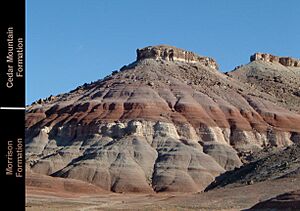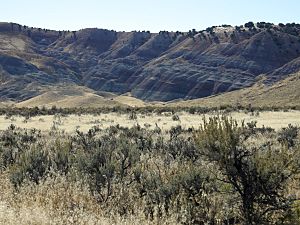Morrison Formation facts for kids
The Morrison Formation is a special set of rock layers found in the western United States. It's famous because it's the best place in North America to find dinosaur fossils! These rocks were formed during the Jurassic period, about 156 to 147 million years ago.
The Morrison Formation is made up of different kinds of rocks like mudstone, sandstone, siltstone, and limestone. They can be light grey, greenish grey, or even red. Most of the dinosaur fossils are found in the green siltstone and lower sandstone layers. These rocks tell us about the ancient rivers and floodplains that existed during the Jurassic period.

Contents
Where is the Morrison Formation Found?
The Morrison Formation stretches across a huge area, about 1.5 million square kilometers (600,000 square miles)! You can find it in states like Wyoming, Colorado, Montana, Utah, and many others. Even though it covers a vast area, only a small part of it is visible on the surface for geologists and paleontologists to study. Most of it is still buried deep underground.
The first dinosaur fossils in the Morrison Formation were found in 1877 by a person named Arthur Lakes. This discovery led to a big competition between two early paleontologists, Othniel Charles Marsh and Edward Drinker Cope, who were both trying to find the most fossils. This time was known as the "Bone Wars."

In some areas, like Colorado, New Mexico, and Utah, the Morrison Formation was also an important source of uranium, a special metal used for energy.
What Was the Environment Like?
During the time the Morrison Formation was created, the Earth looked very different. The supercontinent of Laurasia had just started to break apart into North America and Eurasia. North America was moving north and was in a warm, subtropical area.
The land where the Morrison Formation now sits was mostly low-lying. Rivers, lakes, and swampy areas covered the landscape. As the early Rocky Mountains began to rise in the west, they pushed sediment (like sand and mud) down into a large basin. This sediment was carried by rivers and then settled in the lowlands, forming the layers of rock we now call the Morrison Formation.
In the northern parts, near what was then the Sundance Sea, there were many swamps and lots of plants, which is why coal can be found there. But in the southwestern parts, it was much drier, like a desert with sand dunes, showing how varied the environment was.
Dinosaur National Monument
Dinosaur National Monument is a special park located on the border of Colorado and Utah. It's famous for its amazing dinosaur fossil beds, often called the Dinosaur Quarry. Here, you can see many dinosaur fossils, including meat-eaters like Allosaurus and huge long-necked dinosaurs called sauropods.
The fossil beds were discovered in 1909 by a paleontologist named Earl Douglass. He and his team dug up thousands of fossils and sent them to the Carnegie Museum in Pittsburgh, Pennsylvania, for study. In 1915, President Woodrow Wilson made the area a National Monument to protect these important discoveries. The monument was later made much larger to include the beautiful river canyons nearby.
What Dinosaurs Lived Here?
The Morrison Formation is like a treasure chest for dinosaur fossils! Many different types of dinosaurs have been found here.
- Meat-eating dinosaurs (Theropods):
- Long-necked dinosaurs (Sauropods): These were some of the biggest animals to ever walk the Earth!
- Apatosaurus
- Diplodocus
- Brachiosaurus
- Camarasaurus
- Amphicoelias (possibly the largest dinosaur ever!)
- Plated dinosaurs (Stegosaurs):
- Stegosaurus
- Hesperosaurus
- Plant-eating dinosaurs (Ornithopods):
These incredible fossils help scientists learn more about what life was like millions of years ago during the Jurassic period.
Images for kids
-
"Popcorn" texture due to bentonite, formed from volcanic ash, characterizes the Brushy Basin Member
See also
 In Spanish: Formación Morrison para niños
In Spanish: Formación Morrison para niños









